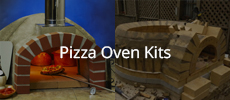Well it took me more than one day to finish the dome but today I did it.
Somehow the last tree rows ended up slightly out of round so there was lots of custom cuts in the last 2 rows and this took a hell of a long time to finish. The plug ended up an odd shape, I spent a lot of time cutting it so it would fit snug.
I removed the support to reveal the dome top. All the joints look fairly tight and I could see there were a few spots where the mortar didn't ooze out the bottom, maybe a few mil short. I reckon I could have left it as it was but just to be sure I made a mortar mix and substituted one part sand (of 3 parts) with the firebrick dust and filled the gaps.
Looks like I've got a big clean up to do where the drips have dried against the bricks, that'll be another day. Too bloody hot today (36 degrees) Hope the heat doesn't affect the mortar too much, the bricks I've been working with have been soaking for days so there should be a fair bit of water in them.
Will sit back a while and think through how I'll tackle the front arch and landing. I'm thinking of having a step down from the hearth. Tomorrow I'll have to tend to the property (mowing and slashing).
Announcement
Collapse
No announcement yet.
Build started in Mountain Top NSW
Collapse
X
-
Thanks for the compliments Gretsch. If I would have known anything about laying bricks, I probably wouldn't have tried the teardrop shape ...but I'm really happy with the shape and the ash slot/dump. As most have said here, my main regret is that I should've insulated more
...but I'm really happy with the shape and the ash slot/dump. As most have said here, my main regret is that I should've insulated more  Last edited by SableSprings; 12-20-2017, 02:00 PM.
Last edited by SableSprings; 12-20-2017, 02:00 PM.
Leave a comment:
-
Being able to determine how much mortar is getting down to joints is one of the problems with a sand dome. May likely will require some pointing and tucking unless you have some really tight internal joints like you had with the IT setup. You did good making it over the arch despite having to deal with an different type of tapered arch configuration, You are on the home stretch.
Leave a comment:
-
Now that I'm over the top and getting horizontal I had to ditch the IT for a sand dome. I'm cutting the bricks to not quite 1/3rd of a full brick so there's some waste. Well not entirely, some have come in handy for small wedges to get past where the mortar gaps line up. The following row (row 9) I'm getting 1/3rd bricks with very little waste.
Up until and including this course I've left one side of the brick square and bevelled the other but as the angle is getting bigger the square face is starting to gain height over the angled face. So from the next course on I began cutting both sides. I made a simple jig (well, two jigs) a piece of timber and a screw in the side of it, butt the brick one edge against the screw gives me exactly the right amount of angle for my cut. The second jig has the screw at twice the depth of the first for the second cut. (I think that's clear)
So now I don't have gaps between brick sides I'm using refractory glue there and homebrew between the rows. I just hope I'm getting enough mortar down there, it's hard to tell if it's getting all the way down to the bottom.
Yeah...It's starting to look like an igloo !!! Another day and I reckon I'll have it plugged.
It's hot out here, reckon I need a home brew or 2 myself... 3 Photos
3 Photos
Leave a comment:
-
Some photos of how I cut the bricks around the arch with cardboard cutouts and how much lift I had to give the bricks against the arch.
I ground the back of the arch bricks a little to make it easier to lay the course.4 PhotosLast edited by Gretsch; 12-16-2017, 03:27 AM.
Leave a comment:
-
Mike, thanks for the info, long wind is good
Great tip drilling a big hole to let the sand out, I wasn't looking forward to cleaning up all that sand! Unfortunately Amazon won't ship to Australia, but a quick google came up with several sources and I know a few wood heater manufacturers in town so I'll see them next time I go. I don't have a sawzall (we call it a reciprocating saw) but I do have a multi tool that'll do the job no worries. The heat breaks thread was quite informative and I've now formulated a solution in my mind which I'll put into motion when the time comes.
Yes I do want to preserve as much heat as possible so I can do lots of different things as it slowly cools down. I usually have buckets of fruit and veggies to dehydrate each year and my poor little electric dehydrator just can't keep up.
Another thing I learnt somewhere in this forum was how lime in mortar makes concrete more water tight and less brittle. If I had known that when I poured my slabs I would have thrown some in the mix. Probably doesn't really matter as I've used insulating fire bricks on my floor and I think they're a glass product and if what I've read is right they don't wick water up. (here's hoping)!
BTW: I took a look at your build I have to say you did an amazing job, not only does it look bloody good but I don't think I would have attempted the teardrop shape!
Leave a comment:
-
Bummer about the "shim-less supports" but hopefully you've got (or have access to) a sawzall. It'll make the cuts pretty quickly. Make the cuts on the back supports first so the sand/top piece(s) slides (or falls ) away from you. If you used a lot of sand on top, a big spade bit from underneath the supported platform will help "drain" the sand via some holes before you go at the supports.
) away from you. If you used a lot of sand on top, a big spade bit from underneath the supported platform will help "drain" the sand via some holes before you go at the supports.
Check a local dealer that handles stoves & fireplaces for the gasket rope. Here's a link to our (USA) Amazon web site and a fiberglass gasket kit
https://www.amazon.com/inch-Woodstov.../dp/B01ETURR0M
and a graphite/glass variation.
https://www.amazon.com/Rutland-96N-6...8YABEDQCTMHJ27
You should be able to find some very similar materials next time you get into town.
If you are going to make a heat break, don't forget to continue the break across the front of the landing. The purpose is to try to isolate the oven and leaving the floor/landing just leaves an avenue for heat to escape. That said, I think the heat loss here is going to be minimal and you've got to ask yourself...Am I really needing to extend my baking over 3-4 days after a firing? I have poor floor insulation and no heat break and I can cook a chicken the day after I bake bread...
I used firebricks in the lower smoke collection area (I've had flames shooting out the oven and up into the collection hood). But my outer arch doesn't get that direct flame/heat hit, so it's house brick as is the outer facade. Just think where will bricks experience fast (and big) temperature changes...those areas should be firebricks (IMHO). Firebricks can withstand that heat stress where house bricks may not . My front landing bricks are bullnose (house bricks) but they are in front of my ash dump and the bricks extending out of the oven to the ash dump are firebricks (I guess my ash dump is a primitive (and partial) heat break for my cooking floor.
. My front landing bricks are bullnose (house bricks) but they are in front of my ash dump and the bricks extending out of the oven to the ash dump are firebricks (I guess my ash dump is a primitive (and partial) heat break for my cooking floor.
You do not need to extend the hearth insulation beyond the dome arch (here's where some folks add the thermal break to isolate the oven). Just make sure to give yourself an adequate reveal to seat your door properly. Having 2-3 cm reveal all around gives you plenty of wiggle room when placing the door.
Sorry to be so long winded...hope this helps. By the way, I think your inner arch looks great and remember all that "ugly stuff" is going to be hidden with the insulation blanket and final render or cover you end up doing. Relax...your oven is going to produce great pizza and good memories!
p.s If you haven't been following this thread on heat breaks, you might want to take a look...
Last edited by SableSprings; 12-13-2017, 10:56 PM.
Leave a comment:
-
Well I'm over the arch, it was a hell of a job juggling the cuts, it's a bit ugly in the front but some off cuts stuffed in the gaps should hold up, looking from inside there's no big gaps to speak of can't see them yet until I finish the dome and remove the timbers.
One thing... I forgot to shim the supports so I think I'll have to cut them rather than knocking them out and risk breaking the dome
Got a question regarding the landing. I'm going to leave a 10mm gap between the chimney arch and dome arch for a fire break and stuff the gap with some insulation rope (anyone know where I can get some) so I've got some old house bricks I want to use up. Can I use them for the chimney and arch and also the floor landing in front of the dome ? Do I need to extend the hearth insulation layer beyond the dome arch ?1 PhotoLast edited by Gretsch; 12-13-2017, 03:15 PM.
Leave a comment:
-
Thanks for that Mike, I feel a bit more confident in my work. I would think others would be green with envy (sick I know)
(sick I know)
Thatís 8mm over 3 courses = 24mm. 325/510 = 63.7% approx.
Dunno wether that bit lower ceiling height is really going to give it any advantage to bread baking but hey what the heck !
Leave a comment:
-
I think you should just tell people, the oven's tinged green cause it isn't ready yet...sorry, poor joke
The build looks great! The droop is not a structural problem...it's just annoying (IMHO). Lots of builds have had the "problem" and easily resolved it in lots of ways to bring things back to level. Your brick joints look good...no alignment issues and the arch is very nice!
The 63% door height to inner dome height ratio is merely a goal that you want to aim for...my ratio is below 60% and the oven breathes just fine. Reducing your IT length to lower the dome height should not be an issue but neither will your projected ratio of 60.7% (325/535) without the adjustment (lower ceiling 8 mm, 325/527=61.67%).
Leave a comment:
-
Laid row 6 today, 3 or 4 more to go.
Iím seeing that droop around the arch so think Iíll place this brick now that the row is done. I should be able to make a cut that will sit nicely in this corner and angle it to bring it back up level again.
My arch opening height is 325mm, inner dome width is 1070mm so my IT is set to 535mm. Ideally 63% of arch opening is 510mm. So if I start to reduce the IT length down gradually for the next 3 or so rows say around 8mm per row am I going to run into difficulty?
The green tinge in the photo is from the tent I bought to keep the hot sun off me and the bricks.1 Photo
Leave a comment:
-
Thanks for the handy tips (pardon the pun) have been using hand cream morning and night to try and keep my hands from cracking and the gloves are working well. I was just getting lazy and decided to tackle some mortaring without gloves and was I sorry! Took some skin off.
Making progress, I've laid 5 courses, the cuts around the arch are taking forever and the gaps are getting bigger further up and they're doing my head in.
Decided to make a downward cut on the remaining arch bricks with an angle grinder to eliminate all those ridiculous angles. Still getting a droop on the brick that faces the arches, I can't figure out how it's happening. I'm having to push the end along the arch up about 3-5mm higher to stay level, hope the mortar fill doesn't fall out.
Last edited by Gretsch; 12-07-2017, 02:22 AM.
Leave a comment:
-
Another thing that works well to help recover after working with anything containing lime & caustics, is to rinse your hands with plain white vinegar. The gloves certainly help, and as Joe mentioned, the mineral/baby oil hand pre-coat is worthwhile.
For me, I just always ended up with bare hands doing some "little mortar patch or fix" that resulted in itchy & irritated skin. The vinegar rinse neutralized the lime on my hands from my "unprotected mortaring" and soon became S.O.P. for any cement or mortar work on my oven. (...and vinegar is really cheap
and soon became S.O.P. for any cement or mortar work on my oven. (...and vinegar is really cheap  )
)
- Likes 1
Leave a comment:





Leave a comment: